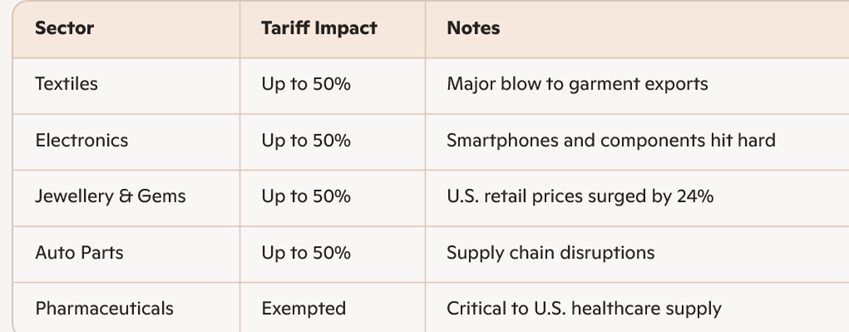Priyanka Sujith
Team Lead, Kreston Rangamani, India
US tariffs and the Indian economy: Crisis or Catalyst?
October 13, 2025
In 2025, US tariffs and the Indian economy hit the headlines, with the U.S.–India trade relationship facing its most dramatic rupture in decades. President Donald Trump’s sweeping tariffs — reaching up to 50% on Indian goods — and a sharp hike in H-1B visa fees sent shockwaves across industries. While headlines focused on textiles, electronics, and auto parts, the deeper story lies in how India’s service sector, especially IT, is responding.
And it’s not just about survival. It’s about transformation.
How did US tariffs impact the Indian economy?
- Tariffs: Three waves of duties imposed between April and August 2025, targeting Indian exports.
- Visa Clampdown: H-1B fees surged to $100,000, disrupting talent mobility and delivery models.
- Strategic Pressure: India’s energy ties with Russia and BRICS alignment triggered geopolitical friction.
Which Indian industries felt the most impact?
Goods sector
The tariffs disproportionately affected consumer and industrial exports:

Service sector fallout
India’s IT giants — TCS, Infosys, Wipro, HCL Tech — saw mixed earnings, margin pressures, and client hesitation. Mid-tier firms like Coforge and Persistent Systems, however, outperformed by staying agile and niche-focused.
While the tariffs directly target goods, the services sector—especially IT and business process outsourcing (BPO)—is feeling indirect pressure:
- IT Services: Roughly 9% of Top 50 companies listed in the National Stock Exchange of India’s revenue comes from U.S. clients, mostly in IT services. Though not tariffed, these firms face reputational risks, contract renegotiations, and slower deal closures due to geopolitical tensions.
- Consulting & Financial Services: U.S. clients may reconsider partnerships amid political uncertainty, affecting India’s $250+ billion services export industry.
- Visa & Mobility Concerns: The trade standoff could lead to tighter U.S. visa norms, impacting Indian tech workers and on-site project delivery.
Despite these risks, India’s diversified service export base and strong digital infrastructure offer some insulation. However, analysts caution that prolonged tensions could erode India’s competitive edge in global services.
While the Trump administration’s tariff escalation poses serious challenges, it also opens up strategic opportunities for India to rethink its trade, technology, and diplomatic playbook
Opportunities for India amid U.S. tariff shock
1. Diversification of export markets
- Pivot to Europe, ASEAN, and Africa: Indian exporters can reduce dependence on the U.S. by expanding into emerging markets with growing demand for textiles, pharmaceuticals, and IT services.
- Leverage FTAs: Fast-track trade agreements with the EU, UK, and Gulf nations could offer tariff-free access and offset U.S. losses.
- A UK-India free trade deal was signed on July 25, reducing most tariffs on goods going both ways.
2. Boost to domestic manufacturing
- Make in India 2.0: The crisis could accelerate investment in local production, especially in electronics, defense, and machinery.
- Import Substitution: With global supply chains shifting, India can position itself as a hub for components and intermediate goods.
3. Strengthening the services sector
- Remote Work Advantage: India’s IT and BPO sectors can deepen ties with non-U.S. clients, especially in Europe and Southeast Asia.
- Digital Infrastructure Push: Government incentives for cloud, AI, and cybersecurity services can help Indian firms scale globally.
4. Strategic energy partnerships
- Middle East & Africa: India can reduce reliance on Russian oil by securing long-term deals with Gulf nations and African producers.
- Green Energy Acceleration: Tariff pressure may push India to invest more aggressively in renewables and energy independence.
5. Innovation and value addition
- Move Up the Value Chain: Instead of exporting raw goods, India can focus on high-margin products like branded apparel, processed foods, and precision engineering.
- Startup Ecosystem: Tariff shocks may spur innovation in logistics, fintech, and export tech platforms.
India’s resilience lies in its ability to adapt, innovate, and lead. This moment, though turbulent, could be the inflection point for a more self-reliant and globally diversified India.
Turning pressure into progress: “Disruption is the birthplace of reinvention.”
The U.S. tariff escalation may feel like a setback, but it’s also a wake-up call—a chance for Indian businesses to evolve beyond traditional dependencies and embrace a more resilient, globally agile future. By diversifying markets, investing in innovation, and strengthening digital capabilities, companies can not only weather this storm but also emerge stronger, smarter, and more self-reliant.
This isn’t just damage control—it’s a pivot toward long-term transformation. The world is watching. And it’s India’s moment to rise and redefine the future.


